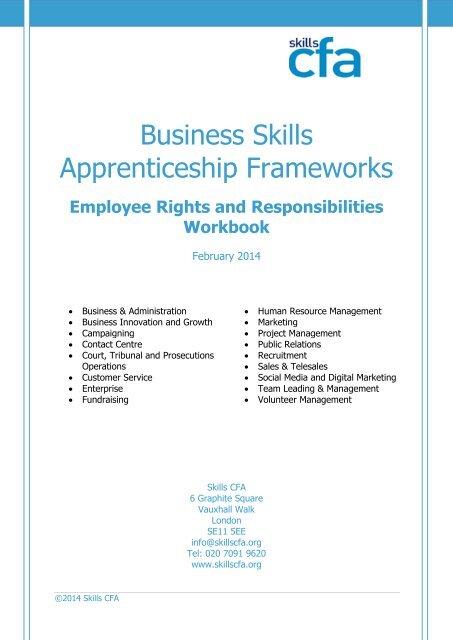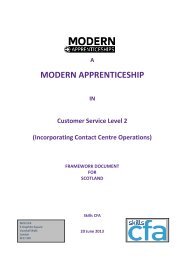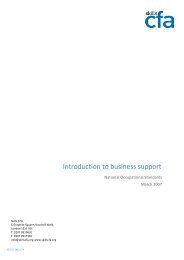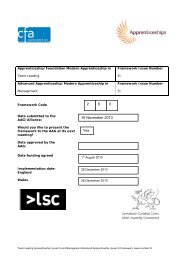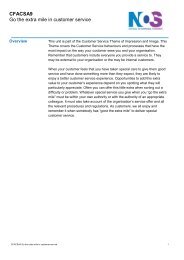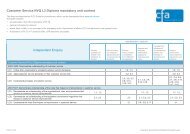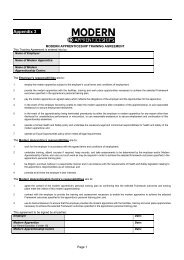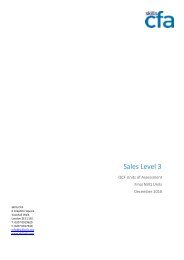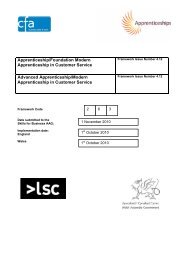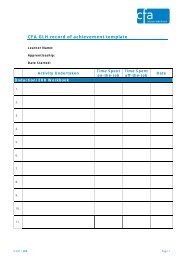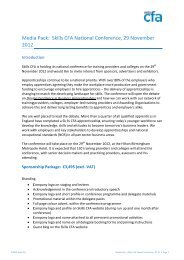(ERR) workbook - Skills CFA
(ERR) workbook - Skills CFA
(ERR) workbook - Skills CFA
Create successful ePaper yourself
Turn your PDF publications into a flip-book with our unique Google optimized e-Paper software.
Business <strong>Skills</strong><br />
Apprenticeship Frameworks<br />
Employee Rights and Responsibilities<br />
Workbook<br />
February 2014<br />
Business & Administration Human Resource Management<br />
Business Innovation and Growth Marketing<br />
Campaigning Project Management<br />
Contact Centre Public Relations<br />
Court, Tribunal and Prosecutions Recruitment<br />
Operations<br />
Sales & Telesales<br />
Customer Service Social Media and Digital Marketing<br />
Enterprise<br />
Team Leading & Management<br />
Fundraising<br />
Volunteer Management<br />
<strong>Skills</strong> <strong>CFA</strong><br />
6 Graphite Square<br />
Vauxhall Walk<br />
London<br />
SE11 5EE<br />
info@skillscfa.org<br />
Tel: 020 7091 9620<br />
www.skillscfa.org<br />
©2014 <strong>Skills</strong> <strong>CFA</strong>
Contents<br />
Welcome and introduction .................................................................................................................. 1<br />
How to use this <strong>workbook</strong> ................................................................................................................... 2<br />
Employee rights and responsibilities outcomes ............................................................................... 3<br />
1 Contracts of employment and grievances ................................................................................. 4<br />
2 Anti-discrimination and equal opportunities ........................................................................... 12<br />
3 Working hours, rest breaks and holiday entitlements........................................................... 20<br />
4 Maternity/paternity, parental and adoption leave ................................................................. 25<br />
5 Absence and sickness ................................................................................................................ 28<br />
6 Data protection and access to personal information ............................................................. 31<br />
7 Health and safety ........................................................................................................................ 33<br />
8 Sources of employment related information, advice and support ...................................... 38<br />
9 About your occupation and organisation ................................................................................ 42<br />
10 Representation ........................................................................................................................ 47<br />
11 Evidence record checklist ...................................................................................................... 50<br />
12 Completion of the <strong>ERR</strong> <strong>workbook</strong> ........................................................................................ 52<br />
13 Useful contacts ........................................................................................................................ 53<br />
14 Glossary of terms .................................................................................................................... 54<br />
©2014 <strong>Skills</strong> <strong>CFA</strong>
Welcome and introduction<br />
Dear apprentice,<br />
It is important that every employee understands his or her rights and responsibilities in the<br />
workplace. There are many laws which protect the safety, well-being and rights of employees at work<br />
and it is important that employees understand their rights and responsibilities relating to them. This is<br />
why learning about your employee rights and responsibilities is a key element of your apprenticeship<br />
programme.<br />
In this <strong>workbook</strong> you will learn about topics such as apprenticeship agreements, contracts of<br />
employment, diversity and equality, and holiday and salary entitlements. Also included in this<br />
<strong>workbook</strong> is vital information relating to health and safety, data protection and discrimination.<br />
This <strong>workbook</strong> may be used as part of your induction programme or as an on-going element of your<br />
apprenticeship studies and the information you learn will be useful for rest of your career, regardless<br />
of the role, sector, or industry you find yourself in.<br />
Your employer and training provider or local college will support you in the completion of this<br />
<strong>workbook</strong>.<br />
I wish you every success with your career.<br />
Kelly Saliba<br />
Associate Director, <strong>Skills</strong> <strong>CFA</strong><br />
©2014 <strong>Skills</strong> <strong>CFA</strong> 1 | P a g e
How to use this <strong>workbook</strong><br />
This <strong>workbook</strong> has been produced by <strong>Skills</strong> <strong>CFA</strong> to develop your understanding of employee rights<br />
and responsibilities (<strong>ERR</strong>) in the workplace.<br />
When completing this <strong>workbook</strong> you will need a clear understanding of your occupation, the industry<br />
in which you work and the sector in which your organisation operates.<br />
As you look through this <strong>workbook</strong> you will note that there are two main areas under each of the<br />
section headings:<br />
WHAT YOU NEED TO KNOW<br />
‘What you need to know’ sections contain a range of information essential to building a well-rounded understanding of<br />
your employee rights and responsibilities.<br />
OVER TO YOU<br />
‘Over to you’ sections provide an opportunity for you to demonstrate your understanding of <strong>ERR</strong>.<br />
You do not need to complete the <strong>workbook</strong> straight away, nor do you have to work through it in any<br />
particular order. Your line manager, training provider, or mentor (if you have one) will be able to<br />
provide help and advice on anything you are unsure of. You may also find it helpful to use your staff<br />
manual and the internet to research some areas in more depth.<br />
©2014 <strong>Skills</strong> <strong>CFA</strong> 2 | P a g e
Employee rights and responsibilities outcomes<br />
Through completing this <strong>workbook</strong> you will achieve the following nine <strong>ERR</strong> outcomes and so will:<br />
1. know and understand the range of employer and employee statutory rights and<br />
responsibilities under Employment Law. This should cover your rights and responsibilities<br />
under the Employment Rights Act (1996), Equality Act (2010) and health and safety<br />
legislation, together with the responsibilities and duties of employers<br />
2. know and understand the procedures and documentation in your organisation which<br />
recognise and protect your relationship with your employer. Health and safety and<br />
equality and diversity training must be an integral part of your learning programme<br />
3. know and understand the range of sources of information and advice available to you on<br />
your employment rights and responsibilities. Details of ‘access to work’ and ‘additional<br />
learning support’ must be included in the programme<br />
4. understand the role played by your occupation within your organisation and industry<br />
5. have an informed view of the types of career pathways that are open to you<br />
6. know the types of representative bodies and understand their relevance to your skill,<br />
trade or occupation, and their main roles and responsibilities<br />
7. know where and how to get information and advice on your industry, occupation, training<br />
and career<br />
8. be able to describe and work within your organisation’s principles and codes of practice<br />
9. be able to recognise and form a view on issues of public concern that affect your<br />
organisation and industry.<br />
©2014 <strong>Skills</strong> <strong>CFA</strong> 3 | P a g e
1 Contracts of employment and grievances<br />
This section covers <strong>ERR</strong> outcomes 1 and 2 (see page 3).<br />
WHAT YOU NEED TO KNOW<br />
Apprenticeship agreements<br />
An apprenticeship agreement is an agreement between an employer and an apprentice in which the<br />
apprentice agrees to undertake work for the employer. It is a written statement outlining the<br />
particulars of employment (hours of work, holiday entitlement, rate of pay etc). The Agreement does<br />
not entitle an apprentice to any additional rights over other employees.<br />
An apprenticeship agreement became a condition for the completion of an apprenticeship on 6 April<br />
2012 due to the Apprenticeships, <strong>Skills</strong>, Children and Learning Act (2009).<br />
An Apprenticeship Agreement can be in the form of a written statement of particulars under the<br />
Employment Rights Act (1996), or a document in writing in the form of a contract of employment or a<br />
letter of engagement where the employer's duty under the 1996 Act is treated as met.<br />
In all cases, a contract of employment is necessary for employment to continue after the completion<br />
of an apprenticeship.<br />
Employment contracts<br />
Employment contracts are legally binding and protect both the employer and employee's rights and<br />
responsibilities.<br />
The legal parts of a contract are known as ‘terms’. The terms of an employment contract set out<br />
what the employee and employer can expect of each other. If there’s anything in your contract that<br />
you’re unsure about, or which is confusing, ask your employer to explain it to you. It is important that<br />
you know what a legally binding part of a contract is and what is not.<br />
A contract of employment can be given to you in a number of different ways, including:<br />
<br />
<br />
<br />
<br />
a written contract (or similar document)<br />
an employee handbook or on a company notice board<br />
a spoken agreement with your employer<br />
an offer of employment letter from your employer.<br />
As soon as a firm offer of employment has been made and accepted, the contract of employment is<br />
in effect , even if this is a spoken agreement (eg at an interview). It is best practice that your<br />
employer gives you a written contract of employment.<br />
©2014 <strong>Skills</strong> <strong>CFA</strong> 4 | P a g e
When a period of employment is set to last for more than a month, all employees are entitled by law<br />
to a written statement of the key terms and conditions of their employment within two months of<br />
starting work.<br />
Conditions of employment which relate to the employee may include information relating to notice<br />
periods, salary/wages, benefits and work hours. Conditions of employment that relate to the company<br />
include discipline/grievance procedures, intellectual property and copyright.<br />
Employment contracts can be permanent, where there is no end date specified, temporary, or for<br />
fixed-terms, where there is a specific end date for the employment.<br />
Changes to employment contracts must be made by following procedures which are designed to<br />
protect the employee from unfair treatment. If employers wish to make any changes in their<br />
employees contracts of employment they must consult on those changes with employees or their<br />
representatives (eg a trade union).<br />
Employment status<br />
There are three types of employment status, which indicate a person’s rights and responsibilities at<br />
work - ‘worker’, ‘employee’ or ‘self-employed’.<br />
<br />
Workers have a contract (not necessarily written) to undertake work in return for reward.<br />
Work should be available to them for the duration of the contract. Workers are entitled to<br />
certain employment rights, including:<br />
o<br />
o<br />
o<br />
o<br />
o<br />
being paid national minimum wage<br />
protection against unlawful deduction from wages<br />
receiving the statutory minimum level of paid holiday<br />
protection against unlawful discrimination<br />
not to be treated less favourably if they work part-time.<br />
<br />
Employees are workers, but have a wider range of employment rights than other workers,<br />
including:<br />
o<br />
o<br />
o<br />
o<br />
statutory sick pay<br />
maternity, paternity and adoption leave and pay<br />
the right to request flexible working<br />
minimum notice periods of their employment will be ending.<br />
<br />
Self-employed people are not generally covered by employment law, except for some things<br />
like health and safety. Rights and responsibilities are determined by the person’s contract<br />
with their client.<br />
Termination of an employment contract is governed by rules and rights which protect the employee<br />
and employer from unfair treatment.<br />
©2014 <strong>Skills</strong> <strong>CFA</strong> 5 | P a g e
Fixed-term and part-time employees<br />
The Fixed-term Employees (Prevention of Less Favourable Treatment) Regulations (2002) seek to<br />
guarantee that employees on fixed-term contracts are not treated less favourably than those who are<br />
employed on equivalent permanent contracts. This includes seasonal agricultural workers, retail<br />
assistants who work over the Christmas period, employees covering colleagues whilst they are on<br />
maternity leave or those employees who are employed to complete specific tasks, such as painting a<br />
house. These regulations give fixed-term workers the same rights to the terms and conditions of<br />
employment as those on permanent contracts.<br />
The Part-time Workers (Prevention of Less Favourable Treatment) Regulations (2000) seek to<br />
guarantee that part-time employees are not treated less favourably than equivalent full-timer<br />
workers. It states that part-time employees:<br />
<br />
<br />
<br />
<br />
<br />
<br />
are entitled to the same rate of pay as a full-time worker<br />
must be provided with the same training opportunities as full-time employees<br />
must be given the same holiday allowance as a full-timer, but at a pro-rata basis<br />
must be offered the same career break schemes as a full-time worker<br />
are entitled to the same contractual maternity and parental leave as full-time employees<br />
must not be treated less favourably during a redundancy process.<br />
Apprentice minimum wage<br />
Apprentices aged between16-18 or in the first year of their apprenticeship must be paid a minimum<br />
of £2.68 per hour. The salary of apprentices aged 19 and over (and not in the first year of their<br />
apprenticeship) must be equivalent to, or above, the national minimum wage for their age (for<br />
information on the National Minimum Wage, look here: https://www.gov.uk/national-minimumwage-rates).<br />
Grievances<br />
If you have a problem or a complaint about your employment in relation to things such as your terms<br />
of employment, work conditions, work relations, organisational changes or health and safety you<br />
have the right to be able to raise these concerns with your employer. This is known as raising a<br />
grievance.<br />
It is your responsibility to inform your employer as soon as possible about any grievance that you<br />
may have. In most instances, you should always first try to resolve the problem informally, before<br />
taking any further action. However if you do decide to take out a formal grievance, you should follow<br />
your employer’s formal grievance procedure.<br />
©2014 <strong>Skills</strong> <strong>CFA</strong> 6 | P a g e
Every employer should have a written grievance procedure which should be easily accessible for all<br />
staff. The procedure should include information about:<br />
<br />
<br />
<br />
<br />
<br />
<br />
how to set out the details of a grievance in writing<br />
who to send the letter to<br />
who to write to if a contact is involved in the grievance<br />
the right to a meeting with the employer to discuss the grievance<br />
how to appeal the employer’s decision<br />
how long each stage should take.<br />
©2014 <strong>Skills</strong> <strong>CFA</strong> 7 | P a g e
OVER TO YOU<br />
Q1 What three elements must an Apprenticeship Agreement contain? (Look here for information:<br />
http://www.apprenticeships.org.uk/Partners/Policy/Apprenticeship%20Agreement.aspx)<br />
1:<br />
2:<br />
3:<br />
Q2 Give three examples of legally-binding contract terms<br />
1:<br />
2:<br />
3:<br />
©2014 <strong>Skills</strong> <strong>CFA</strong> 8 | P a g e
Q3 There are three types of employment status - a ‘worker’, an ‘employee’ or ‘self- employed’. What<br />
are the basic employment rights for each employment status? (Look here for information:<br />
http://www.tuc.org.uk/workplace/tuc-19836-f0.cfm#pyramid)<br />
Name three in each category.<br />
Worker<br />
1:<br />
2:<br />
3:<br />
Employee<br />
1:<br />
2:<br />
3:<br />
©2014 <strong>Skills</strong> <strong>CFA</strong> 9 | P a g e
Self-employed<br />
1:<br />
2:<br />
3:<br />
Q4 If you have a grievance, who would you report it to?<br />
Name:<br />
Job title:<br />
©2014 <strong>Skills</strong> <strong>CFA</strong> 10 | P a g e
Q5 Name three things an organisation’s grievance procedure should contain?<br />
1:<br />
2:<br />
3:<br />
©2014 <strong>Skills</strong> <strong>CFA</strong> 11 | P a g e
2 Anti-discrimination and equal opportunities<br />
This section covers <strong>ERR</strong> outcomes 1 and 2 (see page 3).<br />
WHAT YOU NEED TO KNOW<br />
The Equality Act (2010)<br />
The Equality Act (2010) brought together previous anti-discrimination legislation into one act and<br />
strengthened anti-discrimination in certain areas, covering what are termed ‘protected<br />
characteristics’. These are age, disability, gender reassignment, marriage and civil partnership,<br />
pregnancy and maternity, race, religion or belief, sex and sexual orientation.<br />
There are four types of discrimination covered by the Equality Act (2010). These are direct<br />
discrimination, indirect discrimination, harassment and victimisation:<br />
<br />
direct discrimination is treating someone unfavourably due to a protected characteristic. This<br />
includes associative discrimination and perceptive discrimination:<br />
o<br />
o<br />
associative discrimination is discriminating against an individual because that person<br />
is associated with someone with a protected characteristics<br />
perceptive discrimination is discrimination against an individual because others think<br />
they possess a protected characteristic.<br />
<br />
<br />
<br />
indirect discrimination is where a workplace policy or procedure disadvantages someone with<br />
a protected characteristic<br />
harassment is where an employee finds others’ behaviour offensive<br />
victimisation is the unfavourable treatment of an employee who has supported a complaint<br />
made under the provision of the Equality Act (2010).<br />
The protected characteristics are explored below.<br />
Age<br />
Employers can’t discriminate on the basis of age during recruitment, when only your skills should be<br />
considered. However, some work activities (eg serving alcohol) can only be undertaken by a person<br />
over a minimum age.<br />
Job descriptions should not refer to age (either specifically or by using language that implies an age,<br />
such as ‘mature’, ‘young’ or ‘energetic’), unless this can be justified. Experience, skills and ability<br />
should be considered when these are equivalent to qualifications. Age discrimination also covers<br />
employment terms and conditions, promotions and transfers and dismissals. Your employer cannot<br />
treat you less favourably than others because of your age or apply a practice which would<br />
disadvantage you because of your age, unless it can be justified.<br />
©2014 <strong>Skills</strong> <strong>CFA</strong> 12 | P a g e
The provision for age discrimination gives protection from all four forms of discrimination (direct<br />
discrimination, indirect discrimination, harassment and victimisation).<br />
Disability<br />
Employers cannot discriminate against workers because of a physical or mental disability, nor may<br />
they fail to make reasonable adjustments to accommodate a worker with a disability.<br />
The Equality Act (2010) makes it unlawful to:<br />
<br />
<br />
<br />
<br />
<br />
discriminate directly against disabled employees – that is, to treat staff less favourably than<br />
others because of their disability, because of something connected with their disability, or<br />
because they are associated with (eg care for) someone with a disability<br />
discriminate indirectly against disabled employees – that is, to apply a practice which would<br />
disadvantage them because of their disability, unless it can be objectively justified<br />
subject disabled employees to harassment<br />
victimise disabled employees because they have made, or intend to make, a complaint or<br />
allegation or have given or intend to give evidence in relation to a complaint of discrimination<br />
on the grounds of disability<br />
ask questions, except in certain circumstances, about a disabled employee’s health before<br />
offering them a job.<br />
Gender reassignment<br />
Under the Equality Act (2010), it is unlawful for employers to discriminate against anyone who is<br />
undergoing, has undergone or intends to undergo gender reassignment. Under the Act an employer<br />
is not allowed to discriminate against an employee for absence from work due to the gender<br />
reassignment process.<br />
Also, anyone who is living as another gender, eg a man living as a woman, is also protected through<br />
this provision even if they are not going through a gender reassignment procedure.<br />
Marriage and civil partnership<br />
Under the Equality Act (2010), people who are married or in a civil partnership are protected against<br />
any direct discrimination against them. Due to their status, single people and those in relationships<br />
outside of marriage or civil partnership are not protected under the Act.<br />
Pregnancy and maternity<br />
Pregnant women are protected against any discrimination on the grounds of their pregnancy,<br />
maternity leave or statutory leave entitlements. Discriminatory treatment towards a woman during<br />
the time of her pregnancy is not handled as sex discrimination.<br />
©2014 <strong>Skills</strong> <strong>CFA</strong> 13 | P a g e
A pregnant woman is protected against being dismissed, demoted, or disciplined due to her<br />
pregnancy, maternity leave or statutory leave entitlements. Examples of pregnancy and maternity<br />
leave discrimination include:<br />
<br />
<br />
being dismissed or disciplined due to asking for time off work to attend ante-natal classes<br />
being dismissed or disciplined due to being unable to complete work duties because of health<br />
and safety reasons.<br />
Race<br />
Race discrimination covers all aspects of employment, from recruitment through to pay and training<br />
to terminating a contract of employment.<br />
All four areas of discrimination are covered under race discrimination:<br />
<br />
<br />
<br />
<br />
direct discrimination: someone being treated less favourably based on their actual or<br />
perceived race, or being associated with someone of actual or perceived race<br />
indirect discrimination: policies, practices and procedures that disadvantage people of a<br />
particular race<br />
harassment: when unwanted conduct directly related to someone’s race violates an<br />
individual’s dignity and forms a hostile, humiliating, degrading, or offensive environment<br />
victimisation: the unfair treatment of an employee due to them making or supporting a<br />
complaint directly relating to racial discrimination.<br />
Religion or belief<br />
Under the Equality Act (2010), it is deemed unlawful to discriminate against someone based on their<br />
religion or belief. The provision includes protection for those of all religious beliefs and also those who<br />
have no religious belief. To be covered by this protection a religion must have a clearly defined<br />
structure. A belief may be philosophical or religious.<br />
Organisations should have a fair recruitment and selection process and employment practices that<br />
treat everyone in a fair manner irrespective of their religion or belief.<br />
Sex<br />
Sex discrimination means that an employer cannot discriminate against you because of your gender<br />
(including transgender). Your employer should have policies in place to guard against sex<br />
discrimination in regards to recruitment, pay, training, promotion, discipline and grievances and<br />
bullying. When work is regarded as equivalent under a job evaluation study, or viewed to be of equal<br />
value, everyone has the right to receive equal pay regardless of gender. Employers must always<br />
provide a genuine reason for difference in pay.<br />
The provision for sex discrimination gives protection from all four forms of discrimination (direct<br />
discrimination, indirect discrimination, harassment and victimisation).<br />
Sexual orientation<br />
©2014 <strong>Skills</strong> <strong>CFA</strong> 14 | P a g e
The Equality Act (2010) states that it is against the law for employers to discriminate against workers<br />
based on their sexual orientation. Sexual orientations can be categorised as:<br />
<br />
<br />
<br />
homosexual (same sex relations)<br />
heterosexual (opposite sex relations)<br />
bisexual (same sex and opposite sex relations).<br />
All four areas of discrimination are covered under the provision for sexual orientation discrimination<br />
(direct discrimination, indirect discrimination, harassment and victimisation).<br />
Positive action<br />
Positive action is also covered in the Equality Act (2010). This is where an employer’s actions benefit<br />
a person, or group of people, who, due to a protected characteristic are disadvantaged during the<br />
recruitment process or in the workplace.<br />
For example, The Equality Act (2010) permits employers, under certain conditions, to train employees<br />
of one gender for particular work in which their gender has been under-represented. They may also<br />
encourage the under-represented gender to take up opportunities to do that work. This is known as<br />
positive action.<br />
In some cases, a job can be offered to someone of a particular gender because of what is called a<br />
‘genuine occupational qualification’. Examples could include:<br />
<br />
<br />
<br />
jobs in single-sex schools<br />
jobs in some welfare services<br />
acting jobs that specifically require a man or a woman.<br />
©2014 <strong>Skills</strong> <strong>CFA</strong> 15 | P a g e
OVER TO YOU<br />
Q6 What are the four types of discrimination covered under racial discrimination?<br />
1:<br />
2:<br />
3:<br />
4:<br />
Q7 Give an example of indirect discrimination in terms of race.<br />
©2014 <strong>Skills</strong> <strong>CFA</strong> 16 | P a g e
Q8 Give three examples of aspects of employment that are covered by sex discrimination law. (Look<br />
here for information: http://www.acas.org.uk/index.aspx?articleid=1814)<br />
1:<br />
2:<br />
3:<br />
Q9 Give three examples of when sex discrimination might not apply.<br />
1:<br />
2:<br />
3:<br />
©2014 <strong>Skills</strong> <strong>CFA</strong> 17 | P a g e
Q10 Under what circumstances can positive action be applied?<br />
1:<br />
Q11 Name five aspects of employment relating to age that fall under the protection of the Equality<br />
Act (2010). (Look here for information: http://www.acas.org.uk/index.aspx?articleid=1841)<br />
1:<br />
2:<br />
3:<br />
4:<br />
5:<br />
©2014 <strong>Skills</strong> <strong>CFA</strong> 18 | P a g e
Q12 Give three examples of age discrimination which may occur during the recruitment process.<br />
1:<br />
2:<br />
3:<br />
Q13 Give three examples of disability discrimination.<br />
1:<br />
2:<br />
3:<br />
©2014 <strong>Skills</strong> <strong>CFA</strong> 19 | P a g e
3 Working hours, rest breaks and holiday entitlements<br />
This section covers <strong>ERR</strong> outcomes 1, 2 and 8 (see page 3).<br />
WHAT YOU NEED TO KNOW<br />
Working hours<br />
Working time regulations apply to all employers in the UK, regardless of sector or organisation size,<br />
and are a result of the Working Time Directive and Working Time Regulations Act (1998, amended in<br />
2003).<br />
The weekly maximum working hours for adult workers is 48 hours a week on average. Your working<br />
week is not covered by the working time limits if you have signed a voluntary opt-out agreement (you<br />
can only do this if you are 18 or over), or if you have a job:<br />
<br />
<br />
<br />
<br />
in which you can choose freely how long you will work (eg a managing executive)<br />
in the armed forces, emergency services and police (in some circumstances)<br />
as a domestic servant in private houses<br />
as a sea transport worker, a mobile worker in inland waterways or a lake transport worker on<br />
board sea-going fishing vessels.<br />
There are special provisions which limit the hours that young workers (16 and 17 year olds) can<br />
work. The working time of a young worker must not exceed eight hours a day or 40 hours a week.<br />
This total cannot be averaged out across multiple weeks. There is no opt-out from these regulations.<br />
Apprentices must work a minimum of 30 hours per week. You should also expect to be released from<br />
work for your off-the-job training. Training may be delivered at a college, a specialist training provider<br />
or in your place of work. Your employer may release you on the basis of day-release, or in a block of<br />
a number of days in a row.<br />
Working time regulations are enforced by employment tribunals as well as inspections carried out by<br />
the Health and Safety Executive.<br />
Working times includes regular duties as well as:<br />
<br />
<br />
<br />
<br />
job-related training<br />
job-related travelling time, for example if you are a sales representative<br />
working lunches, for example business lunches<br />
time spent working abroad, if you work for a UK-based company<br />
©2014 <strong>Skills</strong> <strong>CFA</strong> 20 | P a g e
paid and some unpaid overtime<br />
time spent on call at the workplace.<br />
It does not include breaks where no work is done (such as lunch), travel between home and work,<br />
time on call away from the workplace, travelling outside work hours, unpaid overtime you have<br />
volunteered for, paid or unpaid holiday and non-job related training, eg evening classes or dayrelease<br />
courses.<br />
Some employees are excluded from these provisions, and there are some situations which may be<br />
exempt from different parts of the provision (for example, seasonal workers in the run-up to<br />
Christmas or workers in sectors where the work cannot be interrupted on technical grounds such as<br />
with electricity production and transmission, or the fire service).<br />
Holiday entitlement<br />
Full-time workers are entitled to a minimum of 28 days of statutory holiday every year. This<br />
comprises 20 days paid annual leave, plus eight days paid public holidays.<br />
Annual leave for part-time workers is calculated on a pro-rata basis. For example, if 2.5 days per<br />
week are worked, the worker would be entitled to 14 days holiday.<br />
It is important to note that your employer may include bank holidays as a part of your statutory<br />
entitlement and they do not necessarily have to give you your holiday when you want it.<br />
Employees must be given time off work for jury service and can also get ‘reasonable’ time off for<br />
certain public duties, such as being a magistrate or a local councillor. In taking time off for public<br />
duties the amount of time should be agreed between the employer and employee. A request for time<br />
of for public duties can be refused if the employer thinks the length of time is unreasonable. It is up<br />
to the employer whether they pay their employee or not in these cases. It is important that you find<br />
out your employer’s policy for requesting leave, this should be located in your employee handbook.<br />
This will tell you things you need to know, such as the notice that you need to give to your employer<br />
when requesting leave.<br />
Types of breaks<br />
There are different kinds of breaks from work. These include:<br />
<br />
rest breaks (eg lunch breaks and short breaks during the day)<br />
o<br />
o<br />
o<br />
Most workers have the right to take breaks. Your contract of employment will<br />
determine whether these are paid.<br />
Adult workers are entitled to one uninterrupted 20 minute break if they expect to<br />
work more than six hours a day (eg a coffee or lunch break).<br />
Your employer may choose when the break must be taken.<br />
©2014 <strong>Skills</strong> <strong>CFA</strong> 21 | P a g e
daily rest (the break between one work day and the next – for most people, overnight)<br />
o<br />
This break should be at least 11 hours for adult workers.<br />
<br />
weekly rest, when you don’t come into work for full days (eg the weekend).<br />
o<br />
This should be a minimum of an uninterrupted 24 hours a week or an uninterrupted<br />
48 hours a fortnight for adult workers (young workers are defined as being under 18<br />
but over school-leaving age).<br />
The amount of break time you get is usually agreed with your employer (this may be in writing or a<br />
verbal agreement).<br />
There are minimum rest breaks required by law that your employer should provide. Your employer<br />
might have to give you longer than required if this reduces a health and safety risk.<br />
Short rest breaks taken during the day are often paid, but do not have to be unless your contract<br />
says so. Unless you have to remain on call, daily rest and weekly rest are not paid.<br />
There are exceptions to the regulations for some specific job types, such as the armed forces, mobile<br />
workers and rail workers. Break rules may also apply differently to you if you travel long distances to<br />
work, engage in security or surveillance activities, constantly work in different places, or work in an<br />
industry with busy peak periods or a requirement for round-the-clock staffing. They may also be<br />
different in an emergency or risk-of-accident-related role.<br />
©2014 <strong>Skills</strong> <strong>CFA</strong> 22 | P a g e
OVER TO YOU<br />
Q14 What is ‘working time’?<br />
Q15 What are the maximum hours allowed at work for those aged between 16 and 17?<br />
A day:<br />
A week:<br />
Q16 How many days paid holiday a year are employees entitled to if they are working:<br />
A five day week:<br />
A three day week:<br />
A two day week:<br />
©2014 <strong>Skills</strong> <strong>CFA</strong> 23 | P a g e
Q17 What is the minimum amount of uninterrupted daily rest that an adult worker should have over<br />
the period of a fortnight?<br />
Q18 How much notice do you need to give to your employer when applying for annual leave?<br />
Q19 How much annual leave are you entitled to?<br />
©2014 <strong>Skills</strong> <strong>CFA</strong> 24 | P a g e
4 Maternity/paternity, parental and adoption leave<br />
This section covers <strong>ERR</strong> outcomes 1, 2, 8 and 9 (see page 3).<br />
WHAT YOU NEED TO KNOW<br />
Parents are entitled to a period of maternity, paternity and/or parental leave, which can be paid or<br />
unpaid.<br />
Maternity leave<br />
Employers cannot automatically dismiss a woman because she is pregnant.<br />
All pregnant employees are entitled to take up to one year’s (52 weeks) maternity leave, regardless<br />
of length of service with the employer, but only 39 weeks are paid for.<br />
Statutory Maternity Pay (SMP) is paid for 39 weeks and is made up in the following way:<br />
<br />
<br />
90% of your average weekly earnings before tax for the first six weeks<br />
for the remaining 33 weeks the standard rate or a rate equal to 90% of your average weekly<br />
earnings, whichever is lower ( the standard rate of SMP is £136.78 and is revised every April).<br />
To qualify for maternity pay you must be employed by the same employer continuously for at least 26<br />
weeks into the 15th week before the week your baby is due.<br />
Women must give eight weeks’ notice when changing their date of return from maternity leave.<br />
Optional ‘keeping in touch’ days have been introduced enabling women to work for up to 10 days<br />
during the maternity leave period. ‘Keeping in touch’ days are paid and must be agreed by the<br />
employer.<br />
All women have a right to return to work after maternity leave, regardless of the size of the<br />
employer.<br />
Paternity leave<br />
New fathers can take either one week or two consecutive weeks’ paid Ordinary Paternity Leave. To<br />
qualify for Ordinary Paternity Pay you must give your employer a SC3 form at least 28 days before<br />
you wish the pay to start. The statutory pay for Ordinary Paternity Leave is £136.78, or 90% of your<br />
average wage (whichever is lower). All paternity leave allowance must be taken in one block.<br />
Ordinary Paternity Leave can be taken by both biological and adoptive parents and includes both<br />
heterosexual and same-sex couples.<br />
©2014 <strong>Skills</strong> <strong>CFA</strong> 25 | P a g e
The Additional Paternity Leave Regulations (2010) entitle employees who are fathers, partners of<br />
mothers, or adopters, to take up to 26 weeks’ paternity leave in the first year of the child’s life or its<br />
placement for adoption. This legislation applies equally to both heterosexual and same-sex couples.<br />
The first two weeks of leave must be taken by the mother, to allow time for recovery. After this<br />
period the option to end maternity leave is available and parents can opt to share the remaining leave<br />
entitlement.<br />
Parental leave<br />
Parental leave is a right for parents to take unpaid time off work to look after a child or make<br />
arrangements for the child’s welfare. Parents can use it to spend more time with children and strike a<br />
better balance between their work and family commitments.<br />
Provided that they have completed one year’s service with the company, employees get 18 weeks<br />
unpaid parental leave in total for each child. However, strict rules apply to how much can be taken in<br />
any given year and it is only available until the child reaches five years of age or until the adopted<br />
child has been placed for five years or until the adopted child reaches 18 years of age. Parents of a<br />
disabled child may take their 18 weeks until the child reaches 18 years of age.<br />
Parents can take leave in blocks of one week up to a maximum of four weeks in any given year.<br />
Parents of a disabled child can take the leave in periods of one day at a time.<br />
Time off for dependants<br />
Employees may take a reasonable amount of unpaid leave to handle an emergency relating to<br />
someone who depends on them. An employer can’t penalise employees for this if the reasons for<br />
taking this leave are genuine.<br />
A dependent could include a husband, wife, partner, child, parent, anyone living in an employee’s<br />
household as a member of their family, or someone who reasonably relies on them for help in an<br />
emergency.<br />
©2014 <strong>Skills</strong> <strong>CFA</strong> 26 | P a g e
OVER TO YOU<br />
Q20 How much maternity leave are mothers entitled to and how is it paid?<br />
Q21 What condition applies for women to qualify to receive Statutory Maternity Pay?<br />
Q22 How much paternity leave are fathers entitled to?<br />
Q23 What is parental leave and how long is it for?<br />
©2014 <strong>Skills</strong> <strong>CFA</strong> 27 | P a g e
5 Absence and sickness<br />
This section covers <strong>ERR</strong> outcomes 1, 2, 8 and 9 (see page 3).<br />
WHAT YOU NEED TO KNOW<br />
Employees have a right to receive statutory sick pay (SSP) if they meet certain criteria.<br />
In most cases, apprentices are entitled to SSP. However, if an apprentice has worked less than three<br />
months in an organisation they will not be entitled to SSP.<br />
Employees are allowed by their employers to ‘self-certificate’ the first seven days of their sickness<br />
without the need to get a certificate from their local doctor. However, these arrangements may vary<br />
from employer to employer.<br />
Doctors’ ‘sick notes’ have been replaced with ‘Statements of Fitness for Work’. This means that your<br />
doctor can let you know how your condition affects your ability to work. This will help your employer<br />
to understand how they might be able to help you return to work sooner. Within the Statement, the<br />
doctor may:<br />
<br />
<br />
<br />
advise when you may be fit for work with some support<br />
suggest ways to help you return to work<br />
give information on how your condition will affect what you are able to do.<br />
If a Statement of Fitness for Work is not attainable at any given time, other forms of evidence are<br />
equally acceptable under SSP. This will need to be discussed between the employer and employee.<br />
SSP is paid for the days an employee would have worked, excluding the first three days an employee<br />
is off (unless they have already been paid SSP in the last eight weeks and are still eligible to receive<br />
the pay again). £86.70 per week is paid under SSP and is payable for up to 28 weeks. Some<br />
employers may also pay additional entitlements if employees are unwell.<br />
SSP payments are made by the employer and tax and national insurance is deducted as normal.<br />
To be eligible for SSP, an employee must earn at least £109 before tax, per week. Employees will not<br />
be eligible for SSP if they:<br />
<br />
<br />
<br />
have received the full 28 week payment already<br />
have taken three or more years of ‘linked periods’ of sickness; this includes four or more days<br />
of sickness within eight weeks of each other<br />
are already receiving Statutory Maternity Pay (SMP).<br />
In a case where an employee does not qualify for SSP, their employer must give them a SSP1 form<br />
within seven days of illness starting. To claim SSP, the employee must inform their employer in<br />
©2014 <strong>Skills</strong> <strong>CFA</strong> 28 | P a g e
writing by the deadline set by the employer, or within seven days if a deadline hasn’t been set. If an<br />
employee is unhappy with a decision made by their employer, they should raise the matter with<br />
them. If the problem is unresolved after speaking with the employer, the employee should contact<br />
Her Majesty’s Revenue & Customs’ (HMRC) employee enquiry line (0845 602 1380 -Monday to Friday,<br />
8am to 5pm).<br />
©2014 <strong>Skills</strong> <strong>CFA</strong> 29 | P a g e
OVER TO YOU<br />
You will need to know about your organisation’s requirements for giving notice of absence,<br />
notification of sickness if you are unable to go to work because of ill-health, arrangements for sick<br />
pay, and the procedures that must be followed when returning to work after illness.<br />
Q24 What is the statutory level of sick pay?<br />
Q25 In what circumstances would an employee not qualify for SSP?<br />
Q26 What are the arrangements for notification of sickness in your organisation?<br />
Q27 How much sick pay are you entitled to in your organisation?<br />
©2014 <strong>Skills</strong> <strong>CFA</strong> 30 | P a g e
6 Data protection and access to personal information<br />
This section covers <strong>ERR</strong> outcomes 1, 2, 8 and 9 (see page 3).<br />
WHAT YOU NEED TO KNOW<br />
The Data Protection Act (1998) (DPA) gives individuals the right to know what information is held<br />
about them including the right to find out what personal information is held on computer and most<br />
paper records.<br />
When part of your job requires you to process personal information about others, the checklist below<br />
may help you comply with the DPA. Being able to answer ‘yes’ to every question does not guarantee<br />
compliance, and you may need more advice in particular areas, but it should mean that you are<br />
heading in the right direction.<br />
1. Is sensitive personal data kept separate from other personal data?<br />
2. Do the people whose information I hold know that I’ve got it, and are they likely to<br />
understand what it will be used for?<br />
3. If I’m asked to pass on personal information, would the people about whom I hold<br />
information expect me to do this?<br />
4. Is the information being held securely, whether it’s on paper or stored electronically?<br />
5. Is access to personal information limited to those with a strict need to know?<br />
6. Is personal information accurate and up to date?<br />
7. Do I delete or destroy personal information as soon as I have no more need for it?<br />
8. Have I received sufficient training from my employer in carrying out my duties and<br />
responsibilities under the DPA, and am I putting them into practice?<br />
©2014 <strong>Skills</strong> <strong>CFA</strong> 31 | P a g e
OVER TO YOU<br />
Apart from understanding your rights as an individual, you also need to know your legal obligations in<br />
the workplace and be able to comply with the requirements of the DPA.<br />
Q28 Answer any three questions from the checklist on page 31.<br />
Q29 How do you exercise your right to access your personnel records? (Look here for information:<br />
https://www.gov.uk/personal-data-my-employer-can-keep-about-me)<br />
©2014 <strong>Skills</strong> <strong>CFA</strong> 32 | P a g e
7 Health and safety<br />
This section covers <strong>ERR</strong> outcomes 1, 2, 8 and 9 (see page 3).<br />
WHAT YOU NEED TO KNOW<br />
The Health and Safety at Work Act (1974) is the main legislation covering health and safety in the<br />
workplace. Under this Act, employers and employees have certain responsibilities. These are:<br />
<br />
<br />
<br />
<br />
employers must ensure, as far as possible, the health, safety and welfare at work of all their<br />
employees. Employers should provide and maintain safe systems of work and a safe<br />
workplace. This covers all machinery, equipment and substances used<br />
employees have a duty to take reasonable care to avoid harm to themselves or to others by<br />
their work activities. Employees must not interfere with or misuse anything provided to<br />
protect their health, safety or welfare<br />
employers and employees must ensure they observe all general health and safety regulations<br />
and codes of practice<br />
employers and employees must also ensure they observe all specific health and safety<br />
requirements, ie those that apply to a particular occupation and/or workplace or relate to the<br />
employment of young people.<br />
Laws regarding health and safety apply to all businesses and means there is a responsibility for health<br />
and safety for both the employer and the employee. The purpose of health and safety is to identify,<br />
manage and control risks in order to minimise the likelihood of accidents. The Health and Safety<br />
Executive is the national independent watchdog for work-related health and safety and is responsible<br />
for enforcing of Health and Safety law. In doing so, they have certain powers that they are able to<br />
exercise.<br />
The Health and Safety Executive are able to:<br />
<br />
<br />
<br />
<br />
<br />
enter and inspect places of business<br />
take measurements, photographs and samples<br />
enforce that a particular area or piece of machinery be left undisturbed<br />
seize, render harmless or destroy dangerous items<br />
interview people and acquire information regarding health and safety issues.<br />
©2014 <strong>Skills</strong> <strong>CFA</strong> 33 | P a g e
Employer requirements<br />
Employers must do the following in relation to health and safety:<br />
<br />
<br />
<br />
<br />
<br />
<br />
<br />
<br />
<br />
<br />
<br />
take steps to minimise the risk of harm occurring in the workplace<br />
explain to employees, in a way that they will understand, how risks at work will be controlled<br />
inform employees how to follow emergency procedures<br />
consult with employees and/or their health and safety representatives concerning health and<br />
safety<br />
provide free-of-charge health and safety training<br />
provide all necessary safety equipment and protective clothing for employees free-of-charge<br />
provide drinking water, toilet and washing facilities for employees<br />
provide fit-for-purpose first aid facilities<br />
report any major injuries or fatalities that happen at work to the Health and Safety Executive<br />
have insurance that covers injuries to employees<br />
work with all other employers or contractors sharing business space to safeguard health and<br />
safety.<br />
It is a legal requirement for businesses that employ five or more employees to have a written health<br />
and safety policy. Employers are responsible for informing employees about risk in the workplace and<br />
how to work safely. Health and safety policy needs to take into account how the differing<br />
characteristics of employees can affect health and safety and risk management. Health and safety<br />
policies should also account for any members of the public that may enter the organisation’s<br />
premises.<br />
Employee requirements<br />
Employees must do the following in relation to health and safety:<br />
<br />
<br />
<br />
<br />
follow all health and safety training that has been provided<br />
take reasonable care to protect the health and safety of both themselves and others<br />
inform the appropriate person if they believe that practices, or poor safety measures, are<br />
putting health and safety at serious risk<br />
cooperate with their employer to enable the fulfilment of any legal duty in relation to health<br />
and safety.<br />
©2014 <strong>Skills</strong> <strong>CFA</strong> 34 | P a g e
If an employee has been properly instructed in relation to health and safety, they can be dismissed<br />
for failing to fulfil their obligation to exercise reasonable care to safeguard it.<br />
©2014 <strong>Skills</strong> <strong>CFA</strong> 35 | P a g e
OVER TO YOU<br />
Q30 Name five powers that the Health and Safety Executive have (Look here for further information:<br />
http://www.hse.gov.uk/enforce/enforce.htm#enffinp).<br />
1:<br />
2:<br />
3:<br />
4:<br />
5:<br />
Q31 Name three characteristics that may need to be accounted for within health and safety policy.<br />
1:<br />
2:<br />
3:<br />
©2014 <strong>Skills</strong> <strong>CFA</strong> 36 | P a g e
Q32 Name two responsibilities that employees have under health and safety legislation.<br />
1:<br />
2:<br />
Q33 Give one example of a health and safety regulation and explain how it applies to your<br />
workplace.<br />
Q34 Who is responsible for health and safety at your workplace?<br />
Q35 Who is the health and safety representative in your workplace?<br />
Name:<br />
Job Title:<br />
©2014 <strong>Skills</strong> <strong>CFA</strong> 37 | P a g e
8 Sources of employment related information, advice and support<br />
This section covers <strong>ERR</strong> outcomes 3 and 7 (see page 3).<br />
WHAT YOU NEED TO KNOW<br />
Internal sources of information and advice<br />
You will need to know who to go to for information and advice in your organisation – this can be on a<br />
range of topics related to:<br />
<br />
<br />
<br />
<br />
employment and personnel issues<br />
training<br />
additional learning support (ALS)<br />
assessment.<br />
External sources of information and advice<br />
It is important that you know where to locate information outside your organisation. This can be<br />
obtained from a range of sources, including:<br />
<br />
<br />
<br />
Citizen’s Advice Bureaux<br />
trade unions<br />
Access to Work contact centres.<br />
Additional learning support<br />
Additional learning support (ALS) provides employees with the additional resources to access their<br />
learning. ALS requirements would normally be highlighted during the recruitment process and,<br />
following an initial assessment, would generally be discussed during the apprentice’s induction.<br />
Factors that may require ALS include:<br />
<br />
<br />
<br />
Asperger’s and Autistic Spectrum Disorders (ASD)<br />
attention deficit hyper-activity disorder (ADHD)<br />
dyslexia, dyspraxia or dyscalculia<br />
©2014 <strong>Skills</strong> <strong>CFA</strong> 38 | P a g e
hearing or visual impairments<br />
mental health problems<br />
physical difficulties<br />
missed schooling or interrupted education.<br />
Types of ALS include:<br />
<br />
<br />
<br />
needs assessments<br />
access to and/or the loan of specialist equipment and/or software<br />
information provided on a computer or through different printed formats, such as large print.<br />
Access to Work<br />
Access to Work is a scheme available for disabled people who are employed full-time, part-time,<br />
temporarily, are self-employed, or who are having a job/work trial. The scheme provides assistance in<br />
overcoming work-related obstacles.<br />
To qualify for assistance from the access to work scheme, employees must meet the criteria stated in<br />
the Equality Act (2010), namely: ‘a physical or mental impairment which has a substantial and longterm<br />
adverse effect on [your] ability to carry out normal day-to-day activities’.<br />
Access to Work will pay up to 100 per cent of approved costs for:<br />
<br />
<br />
<br />
travel, where an individual is not able to use public transport<br />
a support worker to provide help in the workplace<br />
a communicator for support at interviews.<br />
Support may also be provided for specialist equipment, adaptations to premises and equipment or<br />
disability awareness training for colleagues. Help will not be given for standard work equipment,<br />
standard business costs or standard health and safety requirements.<br />
©2014 <strong>Skills</strong> <strong>CFA</strong> 39 | P a g e
OVER TO YOU<br />
Q36 Where would you find information within your organisation about the following topics?<br />
Personnel issues:<br />
Training opportunities:<br />
Additional learning support:<br />
©2014 <strong>Skills</strong> <strong>CFA</strong> 40 | P a g e
Q37 Which external sources are available to you for information and advice relating to employment<br />
issues? (Look here for information: http://www.acas.org.uk/index.aspx?articleid=1461)<br />
Health and safety at work:<br />
Equal opportunities:<br />
Data protection:<br />
Access to Work:<br />
©2014 <strong>Skills</strong> <strong>CFA</strong> 41 | P a g e
9 About your occupation and organisation<br />
This section covers <strong>ERR</strong> outcomes 4, 5 and 9 (see page 3).<br />
WHAT YOU NEED TO KNOW<br />
It is important that you know:<br />
<br />
the type of organisation you work for, including:<br />
o<br />
o<br />
o<br />
the number of staff employed<br />
the type of market in which they operate<br />
any issues of public concern that affect your organisation and/or industry.<br />
<br />
<br />
<br />
<br />
<br />
<br />
how your organisation is structured<br />
the different ways in which organisations carry out different functions such as, finance,<br />
operations, personnel, marketing, and health and safety<br />
the different ways in which the tasks outlined above may be split between different people,<br />
departments and/or sites<br />
the type of changes that have been taking place in your area of business over recent years<br />
which may have affected working practices and the way in which the organisation operates,<br />
and the impact, if any, that these changes have had on your organisation and the way in<br />
which your job role is carried out<br />
what steps you should take to try to ensure you interact effectively with colleagues and<br />
contacts in the workplace and why this is important to the organisation<br />
where you need to go to find out about the training and development opportunities within<br />
your organisation.<br />
You also need to know about your occupation. As you are completing a <strong>Skills</strong> <strong>CFA</strong> apprenticeship, this<br />
means that your job role is within what is called the pan-sector area. The pan-sector is a range of<br />
occupations that can be applied to all sectors and industries. This means that your occupation is not<br />
limited to one sector, but can be practiced in all sectors across the economy.<br />
©2014 <strong>Skills</strong> <strong>CFA</strong> 42 | P a g e
OVER TO YOU<br />
Q38 What are the main changes that have taken place in your area of business over the last few<br />
years? You may wish to think about some of the changes in technology or the centralisation of tasks.<br />
List three changes.<br />
1:<br />
2:<br />
3:<br />
Q39 Give an example of how the changes in Q38 have affected roles in your organisation.<br />
©2014 <strong>Skills</strong> <strong>CFA</strong> 43 | P a g e
Q40 Draw a chart of your organisation (or department), including your colleagues’ job roles and to<br />
whom they are responsible. Make sure you include yourself. If your organisation already has a chart,<br />
amend it to include yourself.<br />
Q41 Who would you discuss your training and development options with?<br />
Name:<br />
Job Title:<br />
©2014 <strong>Skills</strong> <strong>CFA</strong> 44 | P a g e
Q42 List three opportunities for training and development provided by your employer. These may<br />
include short courses, qualifications and in-house training.<br />
1:<br />
2:<br />
3:<br />
Q43 Name three occupations that fall within the pan-sector.<br />
1:<br />
2:<br />
3:<br />
©2014 <strong>Skills</strong> <strong>CFA</strong> 45 | P a g e
Q44 List three examples of changes to your personal circumstances that would need to be reported<br />
to your employer, and to whom you would report these changes.<br />
Change:<br />
Report to:<br />
Change:<br />
Report to:<br />
Change:<br />
Report to:<br />
©2014 <strong>Skills</strong> <strong>CFA</strong> 46 | P a g e
10 Representation<br />
This section covers <strong>ERR</strong> outcome 6 (see page 3).<br />
WHAT YOU NEED TO KNOW<br />
Within any industry there are a range of representative bodies that promote the views of a group of<br />
people with common interests.<br />
Representative bodies collect the views of their members and act as their voice in discussions with<br />
other groups on issues that affect them all. Representation occurs both within organisations and<br />
across sectors and industries, and can occur at both local and national levels.<br />
You should have knowledge of:<br />
<br />
<br />
<br />
<br />
any trade unions relevant to your occupation/industry and what membership can do for you<br />
any professional bodies relevant to your occupation/industry and what membership can do<br />
for you<br />
any regulatory bodies relevant to your industry and occupation, for example, the British<br />
Medical Association<br />
the name and role of the Standard Setting Organisation relevant to your occupation.<br />
©2014 <strong>Skills</strong> <strong>CFA</strong> 47 | P a g e
OVER TO YOU<br />
Q45 Name four things that trade unions can do for their members (Look here for information:<br />
http://www.tuc.org.uk/extras/unionsatwork.pdf).<br />
1:<br />
2:<br />
3:<br />
4:<br />
Q46 Name the main trade union for your occupation/industry (Look here for information:<br />
http://www.tuc.org.uk/britains-unions).<br />
©2014 <strong>Skills</strong> <strong>CFA</strong> 48 | P a g e
Q47 Name the Standard Setting Organisation in your sector and briefly explain what it does<br />
Q48 Name any other bodies (professional / regulatory etc.) relevant to your area of business.<br />
1:<br />
2:<br />
3:<br />
4:<br />
©2014 <strong>Skills</strong> <strong>CFA</strong> 49 | P a g e
11 Evidence record checklist<br />
QUESTION<br />
NUMBER<br />
1<br />
2<br />
3<br />
4<br />
5<br />
6<br />
7<br />
8<br />
9<br />
10<br />
11<br />
12<br />
13<br />
14<br />
15<br />
16<br />
17<br />
18<br />
19<br />
20<br />
21<br />
22<br />
23<br />
24<br />
25<br />
26<br />
27<br />
28<br />
29<br />
30<br />
31<br />
32<br />
33<br />
COMPLETED<br />
COMMENTS<br />
©2014 <strong>Skills</strong> <strong>CFA</strong> 50 | P a g e
34<br />
35<br />
36<br />
37<br />
38<br />
39<br />
40<br />
41<br />
42<br />
43<br />
44<br />
45<br />
46<br />
47<br />
48<br />
©2014 <strong>Skills</strong> <strong>CFA</strong> 51 | P a g e
12 Completion of the <strong>ERR</strong> <strong>workbook</strong><br />
On completion of this <strong>ERR</strong> <strong>workbook</strong>, an <strong>ERR</strong> Declaration Form must be downloaded, completed<br />
and maintained in the apprentice’s record of education.<br />
<strong>ERR</strong> declaration forms can be downloaded from the following links:<br />
England: http://www.skillscfa.org/images/pdfs/apprenticeships/resources/<strong>ERR</strong>-Declaration.pdf<br />
Wales: http://www.skillscfa.org/images/pdfs/apprenticeships/resources/ACW-<strong>ERR</strong>.PDF<br />
©2014 <strong>Skills</strong> <strong>CFA</strong> 52 | P a g e
13 Useful contacts<br />
Advisory, Conciliation and Arbitration Service (ACAS)<br />
www.acas.org.uk<br />
Telephone: 08457 47 47 47<br />
Minicom: 08456 06 16 00<br />
Careers Wales<br />
www.careerswales.com<br />
Telephone: 0800 100 900<br />
Citizens Advice<br />
www.citizensadvice.org.uk<br />
Department for Work and Pensions (DWP)<br />
www.gov.uk/dwp<br />
Federation for Industry Sector <strong>Skills</strong> and Standards (FISSS)<br />
www.sscalliance.org<br />
Telephone: 0845 072 5600<br />
Health and Safety Executive (HSE)<br />
www.hse.gov.uk<br />
National Apprenticeship Service - England (NAS)<br />
www.apprenticeships.org.uk<br />
Telephone: 0800 015 0400 / 02476 826482<br />
<strong>Skills</strong> <strong>CFA</strong><br />
www.skillscfa.org<br />
Telephone: 0207 091 9620<br />
Trade Unions Congress (TUC)<br />
http://www.tuc.org.uk<br />
Telephone: 020 7636 4030<br />
©2014 <strong>Skills</strong> <strong>CFA</strong> 53 | P a g e
14 Glossary of terms<br />
TERM<br />
Apprenticeships<br />
DEFINITION<br />
Structured work-based training programmes. These are three<br />
categories of apprenticeship in England and Wales:<br />
• Intermediate Apprenticeships<br />
• Advanced Apprenticeships<br />
• Higher Apprenticeships.<br />
An apprenticeship is made up of competence and knowledge<br />
qualifications, or a combined qualification, along with requirements<br />
for Employee Rights and Responsibility, Personal Learning and<br />
Thinking <strong>Skills</strong>, Functional <strong>Skills</strong> and Transferable <strong>Skills</strong>. It is<br />
important to note that not all apprenticeships have the same<br />
requirements.<br />
Apprenticeship Agreement<br />
Career break<br />
Data protection<br />
Discrimination<br />
Employment contract<br />
Equal opportunities<br />
An agreement entered into between an employer and an<br />
apprentice. This requirement was set out in the Apprenticeships,<br />
<strong>Skills</strong>, Children and Learning Act (2009) and came into force on 6<br />
April 2012. For apprentices who commenced their apprenticeship<br />
on or after that date, an apprenticeship agreement must be in<br />
place.<br />
A period of time out from employment. Traditionally, this has been<br />
for parents to raise children, but it is sometimes used for people<br />
taking time out of their career for personal development and/or<br />
professional development.<br />
The protection of people’s rights and freedoms in relation to the<br />
processing of personal data.<br />
Prejudicial treatment against individuals or groups based on an<br />
actual or perceived characteristic or membership of a category or<br />
group.<br />
An agreement between an employer and employee that forms the<br />
basis of the employment relationship and details the terms and<br />
conditions of employment. An employment contract does not have<br />
to be written, though it usually is.<br />
Legal protection within the employment relationship that ensures<br />
fair and equal treatment of all individuals regardless of sex or<br />
marital status, race, disability, age, sexual orientation, language,<br />
social origin, religious belief or other personal attributes.<br />
©2014 <strong>Skills</strong> <strong>CFA</strong> 54 | P a g e
Flexible working<br />
<strong>ERR</strong> Declaration Form<br />
Grievance<br />
Maternity leave<br />
Minimum wage<br />
National Vocational<br />
Qualification (NVQ)<br />
Paternity leave<br />
Personnel<br />
Professional body<br />
Where an employee is given a certain degree of freedom in terms<br />
of the scheduling of the working day. The employer will specify the<br />
number of hours that must be worked and may also dictate core<br />
hours where the employee must be present.<br />
A declaration signed by the apprentice, assessor and employer to<br />
confirm that <strong>ERR</strong> outcomes have been met by the apprentice.<br />
An employee complaint regarding the action, or intended action, of<br />
their employer.<br />
A period of absence from work which is covered in legislation,<br />
where a woman gives birth and takes care of her infant child. The<br />
duration of the leave will be agreed with the employer. Statutory<br />
Maternity leave is 52 weeks and is made up to 26 weeks of<br />
Ordinary Maternity Leave and 26 weeks of Additional Maternity<br />
Leave. Leave cannot start more than 11 weeks before the due date<br />
and it is required to give the employer at least 8 weeks’ notice if<br />
the return to work date is to be changed.<br />
The lowest amount of remuneration legally allowable for employers<br />
to pay employees for their labour. Minimum wage is dependent<br />
upon the age of the employee. There is also a minimum wage for<br />
apprentices who are in the first year of their apprenticeship and are<br />
under 19.<br />
National Vocational Qualification: vocationally based qualifications<br />
developed from the National Occupational Standards and broken<br />
down into units or ‘modules’.<br />
A leave of absence from work granted to a father in order to take<br />
care of an infant.<br />
A function within an organisation that deals with the people who<br />
work within it. This is also referred to as human resources.<br />
Personnel are involved in all aspects of the employment<br />
relationship from the recruitment process, to training and retraining.<br />
An association, which is usually not-for-profit, which seeks to<br />
further the interests of a particular occupation and those who work<br />
within it. Professional bodies seek to maintain standards and<br />
promote training and ethics within that occupation.<br />
©2014 <strong>Skills</strong> <strong>CFA</strong> 55 | P a g e
Protected characteristics<br />
The protection from discrimination for individuals due to their<br />
membership, or perceived membership, with particular groups. The<br />
following groups are covered:<br />
<br />
<br />
<br />
<br />
<br />
<br />
<br />
<br />
<br />
age<br />
disability<br />
gender reassignment<br />
marriage and civil partnership<br />
pregnancy and maternity<br />
race<br />
religion or belief<br />
sex<br />
sexual orientation.<br />
Sector <strong>Skills</strong> Councils<br />
<strong>Skills</strong> <strong>CFA</strong><br />
Standards Setting<br />
Organisations<br />
Statutory sick pay<br />
Trade union<br />
Working hours<br />
Independent, employer-led, UK-wide organisations, which aim to<br />
develop high quality skills standards with employers to support<br />
productivity, profitability and the enhancement of competitiveness in<br />
UK and overseas markets.<br />
The organisation responsible for the overview of vocational education<br />
and training in business skills areas including Business &<br />
Administration, Management, Marketing and Sales, Customer Service<br />
and Contact Centres. It is responsible for developing standards and<br />
qualifications which are based on best practice in the workplace.<br />
Organisations approved by Government to identify and manage the<br />
learning needs of all workers within their sectors. This includes<br />
developing National Occupational Standards, NVQ/SVQs and<br />
Modern Apprenticeship Frameworks<br />
The minimum pay that an individual can receive if they are too<br />
sick to work. To qualify for Statutory Sick Pay you need to have<br />
been of work for 4 consecutive days. You may get more than the<br />
amount stipulated for Statutory Sick Pay if your company has a<br />
sick pay scheme.<br />
An association of employees for the purposes of improving<br />
working conditions through collective bargaining.<br />
The period of time that an individual spends engaged in gainful<br />
employment. The maximum amount of time that an individual can<br />
work over the period of a week is 48 hours. However, certain<br />
occupations are exempt from this and it is possible to opt out.<br />
©2014 <strong>Skills</strong> <strong>CFA</strong> 56 | P a g e


